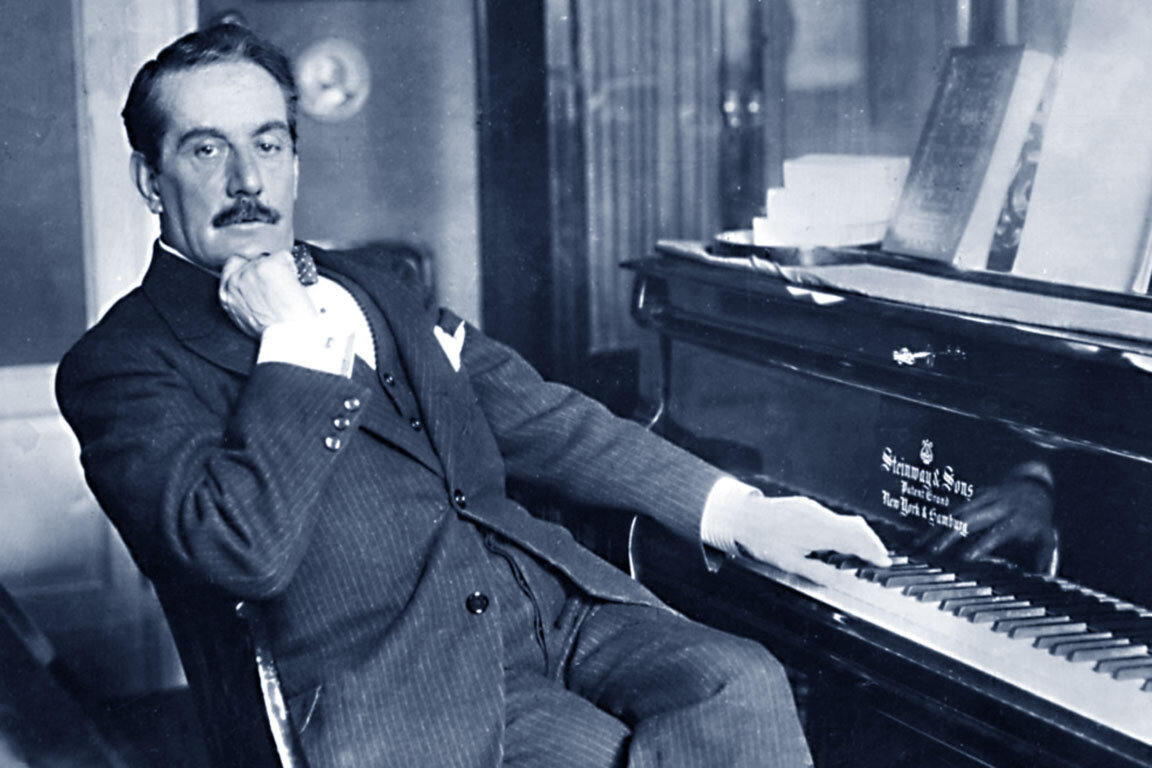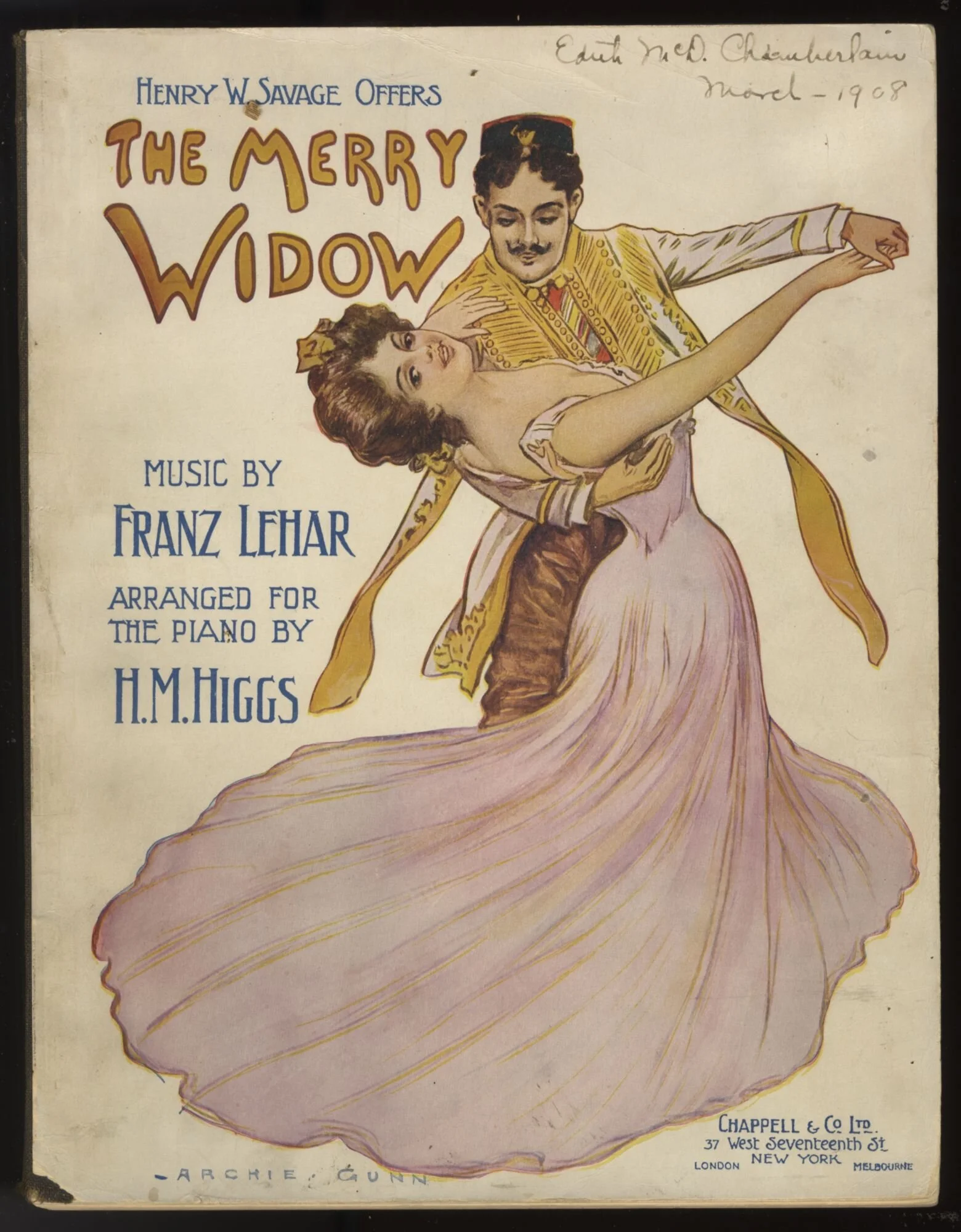Cocktails named after Opera and opera singers
There is a lot of drinking in opera, but we will get to that in another section on drinking songs. There are some cocktail parties. Here are the characters of La Rondine having cocktails in the second act.
And here is a cocktail party in Richard Strauss' Capriccio.
There is also a group of drinks that have been named after specific singers or operas. The opera themed drinks are often invented to celebrate a particular run of an opera, or merely matching a theme that might be derived from the opera.
Mamie Taylor Cocktail - click here for recipe
This tall cooler was given her name and enjoyed great popularity, but disappeared for years before it reappeared due to the new interest in classic cocktails. The Mamie Taylor is like a Scotch highball. You can use any blended Scotch whiskey instead of a single malt. The lime counteracts the sweetness of the ginger beer. The Mamie Taylor is like a Moscow mule, which uses vodka along with lime juice and ginger beer. But the Scotch makes this cocktail more interesting.
"It was while Miss Taylor was the prima donna of an opera company playing at Ontario Beach, near Rochester, in 1899,…that she was asked with a number of other members of the company to go out sailing on the lake. As the day was hot and the breeze rather strong, the party returned after a few hours longing for some cooling refreshments. When Miss Taylor was asked what she would have she expressed the wish for a long but not strong drink--in fact, a claret lemonade. When the drink was served it was very evident that it wasn't a claret lemonade, for it looked like a delicious long drink of sparkling champagne. On tasting it Miss Taylor found it much to her liking, but asked to have the flavor softened with a piece of lemon peel. When this was done the new combination drink was declared a complete success. Bystanders had been watching the proceedings and noticing the evident enjoyment with which Miss Taylor and a few of her friends relished in new drink they finally asked the hotel keeper what drink it was that was being served to them and without hesitation the hotel man replied "a Mamie Taylor" and the name seemed to meet with instantaneous favor and has become famous all over the country."
The Post Standard, 7th March 1902
Madame Butterfly Cocktail - click here for recipe
Madame Butterfly Cocktail
Ricordi cover for Madama Butterfly score
Created by Ektoras Binikos, head mixologist of Aureole Restaurant in New York City to honor the opera by Puccini. It contains Yuzu and Verjus which can be bought online if your grocery store doesn’t have it
The Caruso Cocktail - click here for recipe
Enrico Caruso sang at the Metropolitan Opera, lived in the Knickerbocker Hotel and drank at the Forty-Second Street Country Club the bar in the Knickerbocker. It is hard to tell who created the sweet cocktail that bears his name. Some claim that he invented it, others that a barman at the Country Club named it after him. The martini was said to have been invented by the hotel's house bartender in 1912.
Although some say that the cocktail may have been created by Caruso himself, this is very unlikely, according to the biography of the Neapolitan tenor written by his second wife. Dorothy Caruso, née Dorothy Park Benjamin. The daughter of a wealthy New York patent lawyer, she lived until 1955 and reported that Caruso, “did not drink beer, highballs, milk or tea; he drank two or three quarts of bottled mineral water a day. Sometimes he drank a little wine and the only cocktail he liked was the Alexander." Caruso was a regular smoker of Egyptian cigarettes and this could have contributed to worsening of his physical condition in the final years of his career.
Nellie Melba Champagne Cocktail - click here for recipe
The Australian opera singer Helen Porter Mitchell initially studied to become a piano player, but at the age of 22 Mitchell took up singing lessons. After thorough vocal training in her native country and Paris, the Theater de la Monnaie in Brussels invited her to come and sing as Gilda in Verdi's Rigoletto. Mitchell performed under the artist name Melba (derived from Melbourne), a name that she would use most of her life. From 1918 she was allowed to use the English title "Dame," and she would become as Dame Nellie or Dame Melba. Her debut in the Belgian capital Brussels caused a considerable sensation. Melba then performed alternately in America, Europe, and Australia and became the celebrated star of the Londoner Convent Garden Opera. In 1892 during one of the numerous tours that followed, Melba came into conflict with Georges-Auguste Escoffier, the then famous French chef of the Hotel Savoy in London. The opera singer gave a gala supper and suggested flambéed white peaches for dessert, but Escoffier insisted on serving ice cream. This disagreement ended in a compromise: a new dish consisting of raspberry ice cream with poached peaches, covered with a net of spun sugar. As a token of appreciation for this compromise, Nellie Melba gave Escoffier permission to call this new dessert dish after her.
One legend has it that Melba requested her neighbor, Hans Irvine, a notorious winemaker and then owner of Great Western wines if she could bathe in champagne. Mr. Irvine indulged Dame Melba’s desire and arranged for a bathtub to be brought to the premises and filled with 152 bottles of his sparkling wine – known in those pre-D.O.C. days as champagne. Melba bathed behind a screen: later on cellarmasters bottled the bubbly mixture and claimed that, although 152 bottles were poured into Melba's bath, 153 bottles came out. Various stories on Nellie Melba have inspired as many cocktailians to create tribute cocktails for the Australian diva. Most recipes merely reflect as a liquid mishmash on Escoffier's Peche Melba. This particular recipe for Melba Champagne was first published in Playboy's Host & Bar Book (1971) written by Thomas Mario. - https://cocktailbook.com/melba-champagne/
Puccini Cocktail - click here for recipe
Although created by bartender Gustavo Ferrari as a tribute to the famous Italian opera composer, the origin of this cocktail remains shrouded in mystery.
Giacomo Antonio Domenico Michele Secondo Maria Puccini was an Italian opera composer who has been often referred to as "the greatest composer of Italian opera after Verdi". Puccini's early work was based on traditional late-19th-century romantic Italian opera. Later, Puccini successfully developed his work in the realistic verismo style, becoming one of its leading exponents. Puccini's most renowned works are La Bohème (1896), Tosca (1900), Madam Butterfly (1904), and Turandot (1924), all of which are listed among the important operas played as standards.
Rossini Cocktail - click here for recipe
Gioachino Rossini (1792–1868) was an Italian composer who wrote 39 operas as well as sacred music, chamber music, songs, and some instrumental and piano pieces. His operas The Barber of Seville (1816), Cinderella (1817), and Semiramide (1823), William Tell (1829) are among the best known. Then he decided, at age 37, not to write again for the theatre. At his Paris home and later at his villa in Passy, Rossini gave superb gourmet dinners attended by many of the greats of the musical and literary world of the mid-19th century. Known for his love of food there are several dishes named for him.
Rossini liked to drink Madeira with his macaroni. But here is a cocktail, The Rossini that is made with sweet sparkling wine (Prosecco) and puréed strawberries. The cocktail is the most popular alternative to the classic Bellini.
Verdi Cocktail - click here for recipe
A delicious recipe for Verdi, with gin, peach liqueur, dry vermouth, benedictine herbal liqueur and Blue Curacao liqueur. This was found in 2002 on the menu of the Harvey Nichols Knightsbridge bar. Harvey Nichols is a luxury department store in London open since 1831. Their menu has an extensive list of cocktails in sections divided by parts of London. There is one section, West London, described as “Drinks Influenced by Markets, Culture, Royalty and Unity.” This cocktail was probably in this section. Currently there is a Royal Diva cocktail there.
Salome Cocktail - click here for recipe
Salomé's story was made the subject of a Symbolist play by Oscar Wilde that was first banned in London in 1892 while rehearsals were underway, and that subsequently premiered in Paris in 1896, under the French name Salomé. The opera was first performed at the Königliches Opernhaus in Dresden on 9 December 1905, and within two years, it had been given in 50 other opera houses. Gustav Mahler could not gain the consent of the Vienna censor to have it performed; therefore it was not given at the Vienna State Opera until 1918. The Austrian premiere was given at the Graz Opera in 1906 under the composer, with Arnold Schoenberg, Giacomo Puccini, Alban Berg, and Gustav Mahler in the audience.
The earliest version of this cocktail is found in Straub’s Manual of Mixed Drinks from 1913. It contains both dry and sweet vermouth, gin, orange bitters and celery leaves in the cocktail as well as for garnish. The celery leaves add something to the taste and should not be ignored. To frappé a cocktail is to get it very cold.
Merry Widow Cocktail - click here for recipe
The cocktail, a fancy martini, first appeared in Hugo Ensslin’s Recipes for Mixed Drinks from 1916. It was named after an operetta which was on Broadway in 1907 at the New Amsterdam Theatre. The Merry Widow (German: Die lustige Witwe) is by the Austro-Hungarian composer Franz Lehár. The librettists, Viktor Léon and Leo Stein, based the story – concerning a rich widow, and her countrymen's attempt to keep her money in the principality by finding her the right husband – on an 1861 comedy play, L'attaché d'ambassade (The Embassy Attaché) by Henri Meilhac.
The operetta has been successful since its 1905 premiere in Vienna and often revived and recorded. Films were made in 1934, Maurice Chevalier and Jeanette McDonald, and 1954 with Lana Turner and Fernando Lamas The two most popular numbers are "Vilja Song", and the "Merry Widow Waltz".
Bellini - click here for recipe
The Bellini was invented sometime between 1934 and 1948by Giuseppe Cipriani, founder of Harry's Bar in Venice, Italy. Located just off the Grand Canal, the iconic bar was frequented by the likes of Humphrey Bogart, Truman Capote, and Ernest Hemingway. Though it is not named for the opera composer I include it as well, as being the basis for other opera cocktails like the Rossini with strawberry puree and a Puccini with mandarin juice. Cipriani named the drink the Bellini because its unique pink color reminded him of the toga of a saint in a painting by 15th-century Venetian artist Giovanni Bellini.
Maria Callas Cocktail - click here for recipe
Fernet Branca marketing lore has it that Maria Callas took her Fernet with peppermint syrup, a fact that led, they say, to the creation of the product that eventually became Branca Menta. This is a nightcap in her honor, with some similarities to a drink named for another opera great, the Caruso.






















